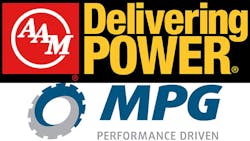American Axle & Manufacturing Holdings Inc. will takeover Metaldyne Performance Group Inc. in a $1.6-billion cash and stock deal that promises to form a global Tier One automotive supplier with powertrain, drivetrain, driveline design and manufacturing. A merger agreement – which has been approved unanimously by directors of both companies — calls for a $1.6-billion exchange of cash and AAM stock, plus the assumption of $1.7 billion in net debt.
A closing is anticipated in the first half of 2017, subject to shareholder and regulatory approval, and other closing conditions.
"AAM's transformational acquisition of MPG brings together two complementary Tier 1 organizations to create a company with greater scale and increased diversity across products, customers and end markets," said David C. Dauch, AAM's chairman and CEO. "MPG's expertise in complex, highly-engineered powertrain components and its global footprint will be tremendous assets to AAM. We are excited about the powerful industrial logic in this combination that will allow us to create additional value for our customers, and other key stakeholders.”
Dauch also predicted increased earnings potential and enhanced cash flow that would reduce leverage and fuel growth, “delivering value to our shareholders."
The principle strategy of the merger is to gain an even larger share of the global automotive supply chain. AAM and MPG have a number of common manufacturing activities, in particular closed-die forging operations producing driveline and drivetrain parts and systems for light trucks, SUVs, passenger cars, crossover vehicles, and commercial vehicles.
MPG also a significant presence in North America casting and machining ductile and gray iron parts for automotive and light truck programs. Both companies have precision machining, finishing, and assembly operations.
Of the two businesses, AAM has a wider global footprint. It designs and produces driveline and drivetrain components and modules, chassis systems, and other formed products. It has seven manufacturing plants and three technical centers in Indiana, Michigan, Ohio, and Pennsylvania, as well as manufacturing operations in Brazil, China, Germany, India, Japan, Luxembourg, Mexico, Poland, Scotland, South Korea, Sweden, and Thailand.
Metaldyne Performance Group was formed in 2014 by a private-equity group, American Securities LLC, which established a single holding company for two forging organizations (Metaldyne, HHI) it owned and a large foundry group (Grede Foundries) it acquired at that time. All three constituent companies had been formed by consolidating a wide portfolio of operations (Blackhawk Foundry, Citation, Cloyes, NovoCast, Jernberg.) over the preceding decade. In September, it rebranded the entire enterprise under the MPG label.
In listing its “compelling strategic rationale” for the merger, AAM emphasized the ability to offer a wide range of highly engineered components and systems to a global customer base. It also pointed to complementary technologies in place at the two organization, concerning “light-weighting, fuel efficiency, vehicle safety and performance.”
AAM also projected an annual “run rate of targeted cost synergies” of $100 million-$120 million by 2018.
Dauch will remain as chairman and CEO of AAM, and the corporation’s board of directors will be expanded to 11 members, including MPG CEO George Thanopoulos.
"This compelling transaction offers MPG shareholders an immediate premium and significant participation in the growth potential of the combined organization and its talented associates,” Thanopoulos assured.
“MPG and AAM share a similar culture and value system, laser focused on quality, operational excellence and technology leadership, which creates a natural fit and clear path to value creation for stakeholders of both companies," he concluded.
About the Author
Robert Brooks
Content Director
Robert Brooks has been a business-to-business reporter, writer, editor, and columnist for more than 20 years, specializing in the primary metal and basic manufacturing industries. His work has covered a wide range of topics, including process technology, resource development, material selection, product design, workforce development, and industrial market strategies, among others.
